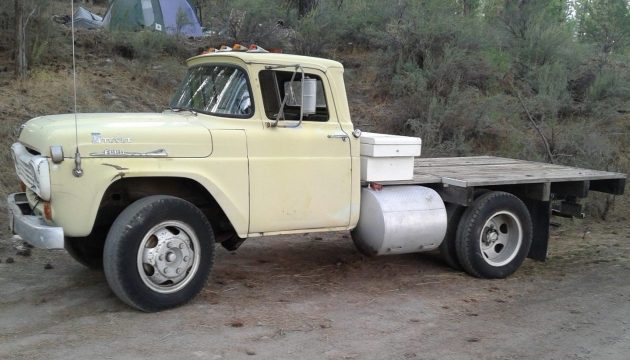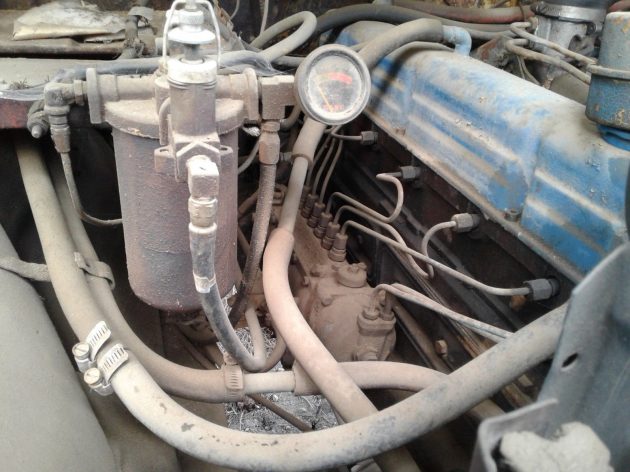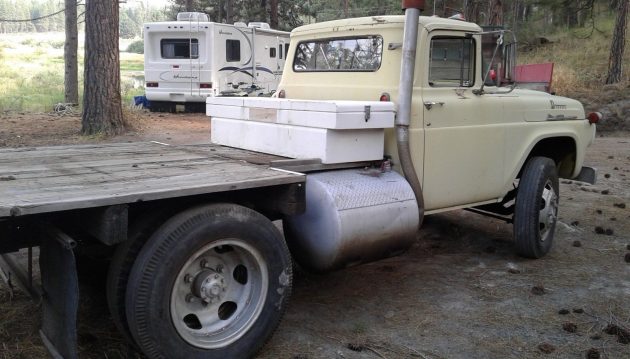This truck is just what you’d expect to find forgotten in a barn and must be what Ford meant by “Built Ford Tough”. At 59 years old, it still looks ready to work, it just needs an engine, and there’s the puzzle. The hole in the block is easy to understand, but the Ford Dagenham diesel engine is puzzling. What’s a “Dagenham” you ask? It’s a marshy place in East London. It’s also the name of a huge factory, at one time the largest in Europe, that has been building Ford cars, trucks, and engines since 1931. In the 1950s there were over 50,000 workers. So, what is a Dagenham diesel doing in an old Ford truck? Was this really an option? The “Diesel” badge on the hood does not look original, so likely the conversion was done by a second party, perhaps for Ford dealers. This truck lacks the usual rust, rats nests, and even dents and is in amazing condition. It’s listed on eBay in Chiloquin, Oregon for $2,600.
Inside is just what you’d expect from an old work truck, including the shag carpet. It looks ready to go to work. Those seats, or at least the upholstery, must be a later addition. There’s no sign of rodent occupation, but there’s also not much for creatures to chew on.
Here’s that Dagenham diesel engine. It’s backed up by a 5-speed transmission and a 2-speed axle. It’s a 220 CID inline six and had about 120 horsepower.
It looks like they took pretty good care of this old truck until the day it died. There’s no word on how long this truck sat after the engine blew up. It could be a great project if other Ford engines will bolt in as the seller states. It won’t be as simple as the seller makes it sound, but it would be possible. This tough old Ford will never be a highway cruiser, though. The chassis looks short enough that the buyer could possibly install a pickup bed and have the ultimate “Cowboy Cadillac”. Or, perhaps, it could just go back to work on a ranch or farm. Hopefully, one of our readers will shed some light on this curious old truck.




In 8 more days you would have had to say it is 60 years old.
Well, I’m a standin’ on a corner in Winslow, Arizona
Such a fine sight to see
It’s a girl my Lord in a flatbed Ford
Slowin’ down to take a look at me…
What’s that part called below the grill, through which the bumper mounts? The valance? That could be hard to buff out.
Great looking work horse.I have never been a fan of diesels in this size truck so I’d Convert it to a 460 ci. or a V10 and pull stumps! This would never be a good “daily driver” unless you got cast iron kidneys. I think it’s got more gauges than a 747, and it doesn’t even have air brakes?
Here’s an artsy Ford farm truck/barn picture from Door County Wisconsin earlier this summer for blue oval fans.
Welding rig!
I’d have to disagree on the model of the truck. It’s a lot heavier than an F-350; I’d have to say closer to a 500 or even a 600.The 350 trucks were pretty wimpy compared to this one.
I’ll have to look it up but in my Ford information there was a spot that told of an optional diesel engine in the COE, but I’ll have to recheck to see if the engine was also available in the conventional cab truck. Looking at this, it must have been. The engine in this one looks to be period correct. It has the early version of the Simms fuel injection pump (later units had what was called a Minimec pump, still made by Simms, or now CAV/Lucas/Delphi). It uses a pneumatic governor which controlled the fuel output by varying the manifold vacuum. The biggest problems with these were engine runaways, usually caused when the vacuum diaphram ruptured and the spring pushed the control rack to the max. 120 hp sounds kind of optimistic; I’d say around 100, maybe. The engine was updated throughout the 60s and the newest versions were used into the 90s before the Cummins B and C series took over. You can still get parts for it; I know of a couple of sources in the UK that sell them, or you can upgrade to something newer.
I’d like to take on a project like this one, simply for the novelty; you don’t see many medium duty Ford trucks from the 50s that are diesel powered….
220 CID? This was basically the same engine that was used in the Fordson Major tractors, with a couple of extra cylinders added. I thought it was closer to 240, or for this era, 270. Something to add: If you want to take on a project like this one you might want to gather up your Whitworth tools. FoMoCo changed most of its UK stuff to Std in the early 60s so this one is likely going to have a lot of Whitworth. S-K used to supply some good sockets; they were Std. but in lots of odd sizes such as 17/32, 19/32, and so on. S-K sure helped me fix my British bikes….
The ad says F550. No 350 had diesel, 5 speed or 2 speed diff.
With the Fair Circuit starting in Texas I sure would love to pull my stock trailer into the grounds with this. Just has more presence than my F350.